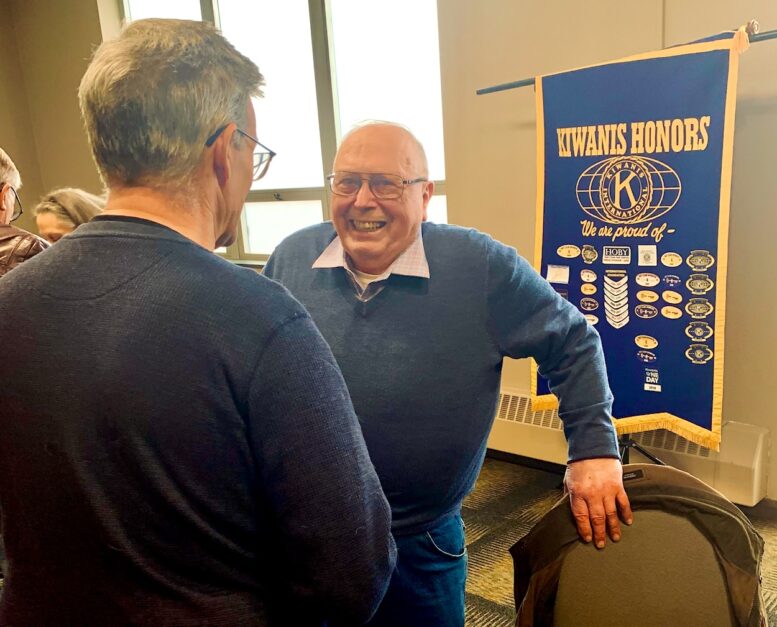By JULIE CARLE
BG Independent News
“You can’t talk about Belleville Brothers Market without talking about family,” Mike Belleville told the Bowling Green Kiwanis Club recently.
At 80, Mike is the patriarch of the Bowling Green business located at 329 S. Main Street. During the talk, he shared some of the family history that provided the backbone of the meat market that has been downtown since 1912.
The business likely wouldn’t have ended up in Bowling Green if Mike’s great, great, great grandfather hadn’t been marched from the Ohio River to Lake Erie to guard ships in the War of 1812. “That was their first experience with northwest Ohio,” he said.
In 1825, the family moved to homestead in Wood County, near what became the Tanglewood Golf Course. His first wife died, and he remarried. Between the two wives, he had 21 children. “There are a lot of people in Wood County that I’m related to,” Mike grinned.
Throughout the 1800s and early 1900s, some family members moved to Michigan, where they started a meat market in Roscommon before eventually moving back to Wood County.
When the family moved back to Wood County in 1909, his grandfather Archie, a brother Leo, along with father-in-law Sam Doty started the first Belleville Market in Bowling Green, he said.
“In those days, it was common for businesses to move from location to location, which is a lot different than what they do now a days,” Mike said.
The first store was on North Main Street, near where Mr. Spots currently is located. In 1914, the business moved to a wood-frame building at 209 N Main St. That building was destroyed by fire, as proof from a photo Mike shared of his grandfather standing among the ashes.
Leo left the meat market to operate a bus between BG, Tontogany and Haskins, but then he left the area to start a meat market in St. Helens, Oregon, Mike said.
In 1918, the store moved to East Wooster Street, just off of Main Street until 1926. When Archie died in 1933, his sons Ivan and Russell – the second generation — took over.
At that time, Belleville Brothers was not the only meat market in the area, according to Mike. Lemmerbrock Brothers had a market on West Wooster Street; the Williamsons had a store in Pemberville; the Davidson family had a slaughterhouse in Maumee; and the Husing family (cousins of the Lemmerbrocks) started a slaughterhouse in North Baltimore.
The brothers initially leased a slaughterhouse on East Gypsy Lane that was owned by the Munn family. built a slaughterhouse in the 1940s and bought the building where Homeworks now sits. “That was the building throughout the ‘40s until the current building was built in 1949,” he said.
Their business boomed during their early years. They were providing meat to Bowling Green State University when the military men were being trained on campus from about 1941-1945. They also provided meat to the Heinz Company to feed the employees in the cafeteria when the plant was in production.
During the 1930s and ‘40s, the brothers bought farmland on Conneaut Avenue, which was sold and became the subdivision Belleville Acres, and on Poe Road, which is where Bowling Green High School now sits, Mike said.
He shared an historical sidenote about land his Uncle Loy who had purchased on the south side of Poe Road. Eventually the land was sold and became Darlyn Drive, named for his two grandchildren, Daryl and Linda.
His father Ivan bought farmland at the end of Conneaut that runs into Liberty Hi Road. The family still owns that, as well as other property on Liberty Hi.
The third generation – Mike and Jamie – took over completely when their father passed away in 1975.
“Over the years we have raised quite a few cattle. My brother, Jamie, and I expanded the operation into what it is today as far as a feeding operation,” Mike said.
“We started with one cattle barn and now we have three, which makes it possible to sell our own beef every month and every week of the year,” he said.
From 1965 to 1999, the Bellevilles worked with Henry Packing Co. in Perrysburg to slaughter their animals. “Every week we’d load cattle, and they would slaughter them and bring the meat back to us,” he said. When they closed because of a lack of customers, there was one other local slaughterhouse.
Jamie and Mike took the owners out for dinner one night to talk about their options, “and by the end of that night, we had bought another slaughterhouse,” Mike recalled. “I went home and told my son (Ivan), who had just graduated from Ohio State University, that on Monday morning, he would be reporting to work in North Baltimore as manager.”
The business has been in the same location for more than 70 years. “You might not notice it from the front of the building, but we have expanded,” Mike said.
They moved the refrigeration by adding an outside cooler, which both increased the capacity for refrigeration and created more working space in the building.
As Jamie and Mike got older, they knew they needed help in the store. Cue up the fourth generation. That was when Ivan indicated he would like to come back to Bowling Green to work in the store, and Jamie’s son, Bruce, moved in to focus on the farm operation. Jamie passed away in November 2021.
The local advantage
The market sells a variety of groceries that customers might need, but it’s the quality of the meat—beef, pork and chicken—that keeps customers coming back.
“We have most everything you could want in meat,” he said. And all the beef is locally fed on their farms.
Beef can be sold by the sides or quarters. They sell different bundles of pork, beef and chicken. The chickens are raised on Amish farms in northern Indiana.
“We also sell all kinds of patties, in different flavors and different sizes such as half pounders, third-pounders or quarter-pounders,” he said.
Among the fan favorites are the Pork-A-Leans, which were first sold at the Wood County Fair in the 1970s as a promotional campaign by the Wood County Pork Producers to encourage people to eat more pork.
“We developed the meat patties and had a contest to name it,” Mike said. “My dad and uncle had perfected the seasonings back in the 1930s. We kept the recipe, so if anyone wants to ask about it, I can’t tell you. It’s a family secret.”





